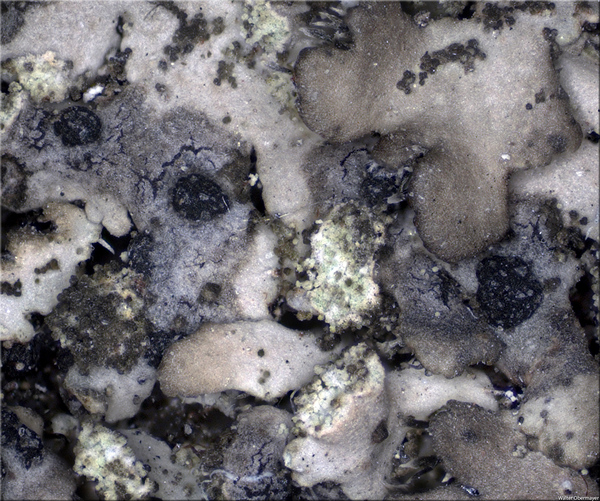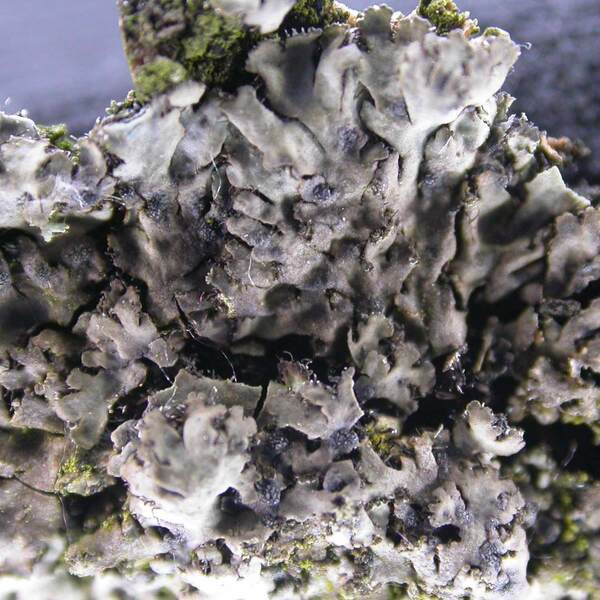Arthonia phaeophysciae Grube & Matzer
Bibl. Lichenol., 68: 10, 1997.
Synonyms: Bryostigma phaeophysciae (Grube & Matzer) S.Y. Kondr. & J.-S. Hur
Description: Thallus inapparent, not lichenized, the hyphae developing inside the thalli of Phaeophyscia-species; strongly infected parts of the hosts become necrotic and blackened and may be covered in thallospores of the parasite. Apothecia arthonioid, emarginate, breaking through the upper cortex of the host, more or less round, 0.1-0.3 mm across, with a black, sometimes grey-pruinose (remains of the epinecral layer of the host), flat to slightly convex disc, without a proper margin. Proper exciple poorly developed; epithecium pale olive-brown, 10-25 µm high; hymenium colourless, 30-40 µm high, I+ red, K/I+ bluish then reddish; paraphysoids branched and anastomosing, vertically oriented, 2-3 µm thick; hypothecium colourless to pale brown, 20-25 µm high, K+ grey. Asci 8-spored, broadly clavate to subglobose, semi-fissitunicate, with a large, non-amyloid apical dome, a distinct ocular chamber, and an amyloid ring-structure in tholus, Arthonia-type. Ascospores 1-septate, very slightly constricted at septum, hyaline, obovate, 12-14 x 4-6 µm, with a gelatinous epispore. Photobiont absent. Spot tests: K-, C-, KC-, P-. Chemistry: without lichen substances.
Growth form: Lichenicolous fungus
Substrata: bark
Reproductive strategy: mainly sexual
paras Phaeophyscia spp.
Commonnes-rarity: (info)
Alpine belt: absent
Subalpine belt: absent
Montane belt: very rare
Dry submediterranean belt: rare
Humid submediterranean belt: absent
Padanian area: extremely rare
pH of the substrata:
1 2 3 4 5
Solar irradiation:
1 2 3 4 5
Aridity:
1 2 3 4 5
Eutrophication:
1 2 3 4 5
Poleotolerance:
0 1 2 3
Altitudinal distribution:
1 2 3 4 5 6
Rarity
absent
extremely rare
very rare
rare
rather rare
rather common
common
very common
extremely common
Loading data...
Occurrence data
Predictive map
Growth form: Lichenicolous fungus
Substrata: bark
Reproductive strategy: mainly sexual
paras Phaeophyscia spp.
Commonnes-rarity: (info)
Alpine belt: absent
Subalpine belt: absent
Montane belt: very rare
Dry submediterranean belt: rare
Humid submediterranean belt: absent
Padanian area: extremely rare
pH of the substrata:
| 1 | 2 | 3 | 4 | 5 |
Solar irradiation:
| 1 | 2 | 3 | 4 | 5 |
Aridity:
| 1 | 2 | 3 | 4 | 5 |
Eutrophication:
| 1 | 2 | 3 | 4 | 5 |
Poleotolerance:
| 0 | 1 | 2 | 3 |
Altitudinal distribution:
| 1 | 2 | 3 | 4 | 5 | 6 |
Rarity
absent
extremely rare
very rare
rare
rather rare
rather common
common
very common
extremely common
Loading data...
Occurrence data
Predictive map








